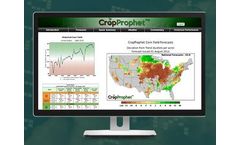- Home
- Software
- asia middle east
- crop yield forecasting
Show results for
Refine by
Locations
- Asia & Middle East
- Afghanistan
- Armenia
- Azerbaijan
- Bahrain
- Bangladesh
- Bhutan
- Brunei Darussalam
- Cambodia
- China
- East Timor
- Georgia
- Guam
- India
- Indonesia
- Iran
- Iraq
- Israel
- Japan
- Jordan
- Kazakhstan
- Kuwait
- Kyrgyzstan
- Laos
- Lebanon
- Malaysia
- Maldives
- Mongolia
- Myanmar
- Nepal
- North Korea
- Oman
- Pakistan
- Palestinian Territories
- Philippines
- Qatar
- Russia
- Saudi Arabia
- Singapore
- South Korea
- Sri Lanka
- Syria
- Taiwan
- Tajikistan
- Thailand
- Turkmenistan
- United Arab Emirates
- Uzbekistan
- Vietnam
- Yemen
Crop Yield Forecasting Software Available In In Asia Middle East
4 software items found
by:Prescient Weather Ltd based inState College, PENNSYLVANIA (USA)
CropProphet uses machine learning and long histories of weather and crop data to accurately predict crop yield and production. Since 2009, CropProphet has delivered crop predictions with greater accuracy and lead time than other ...
by:Cropway based inRaipur, INDIA
Geospatial crop advisory & farm intelligence: Enhance productivity with Cropway’s own self-help AI-powered tools that provide real-time price forecasting, pest/disease detection, fertiliser calculation, yield, and crop prediction. ...
by:Farmnxt Inc. based inOttawa, ONTARIO (CANADA)
Contract farming has been one of the mainstays of commercial agricultural production. It benefits both farmers and processing/marketing companies. farmNXT™ supports contract farming by enabling managed technical support, optimizing cultivation practices, and scheduling material inputs. This ensures profitable crop prices for farmers, and consistent and predictable supply of crops for ...
by:Kheti Buddy based inPune, INDIA
Resolving production bottlenecks with DeepTech. Agriculture is a critical part of the global economy, but it's also one of the most challenging sectors to operate in. Agriculture is challenged by the growth of the global population at an alarming rate, and with it the demand for food. It's estimated that we'll need to produce 70% more food by 2050 to meet the needs of the world's population. ...




